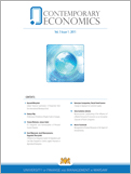Environmental Effects of Mix Energies on the Most Polluted Asean Economies
Environmental Effects of Mix Energies on the Most Polluted Asean Economies
Author(s): Thanaporn Sriyakul, Ruihui Pu, Thitinan ChankosonSubject(s): Business Economy / Management, Energy and Environmental Studies, Environmental and Energy policy, Human Ecology, Accounting - Business Administration
Published by: VIZJA University
Keywords: Mix energies; solar electricity; fossil fuel; wind electricity; hydro electricity; nuclear-power electricity; geo-thermal electricity;
Summary/Abstract: The study aims to investigate the environmental effects of mix energies on the three most polluted countries of ASEAN economies. The study uses the data of the Philippines, Vietnam, and Thailand over the period of 1995-2017 as gathered from the World Bank and Global Economy. The study uses Brush Pagon LM and Pearson CD to test the cross-section dependence among variables while Levin et al. (2002) panel unit root test to check the stationary in the data. Westerlund (2007) cointegration and FMOLS tests are applied to analyze the long-run relationship. The result confirms the adverse environmental effects of fossil fuel electricity generation (FEG) and positive environmental effects of solar electricity generation (SEG), nuclear-power electricity generation (NEG), and geothermal electricity generation (GEG) on the ASEAN economies. Wind electricity generation (WEG) and hydroelectricity generation (HEG) do not significantly contribute to deteriorating the environment. The study suggests using GEG, WEG and SEG methods of producing electricity instead of FEG.
Journal: Contemporary Economics
- Issue Year: 14/2020
- Issue No: 4
- Page Range: 592-603
- Page Count: 12
- Language: English

